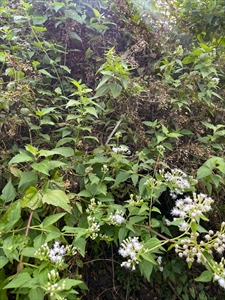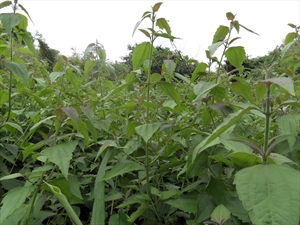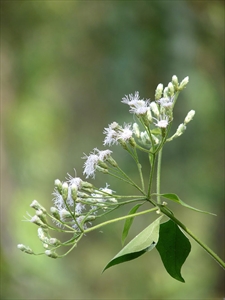- Worldwide. In Australia (Queensland, under eradication), Federated States of Micronesia, Guam, Marshall Islands, Northern Mariana Islands, Palau, Papua New Guinea.
- Major invasive weed: rapid growth, massive seed production, with economic and environmental impacts. Favours range of soils, forming dense tangled thickets overgrowing crop and forest plantations, pastures and native vegetation. Present also in neglected fields, wastelands, roadsides, riverbanks. Produces root chemicals inhibiting competitors (allelopathic).
- Multi-branched, 2.5m tall, round, yellowish stems, woody at base. Leaves, triangular, three-veined, serrated margins, in pairs on short stalks. Flowers, fluffy white to pale at end of stems. Seeds, narrow with white bristles. Swollen 'basal bulb' - storage organ.
- Spread: seeds on wind, water, hooked to clothing, animals, machinery. Forestry and pasture seed contaminant, in soil, sand and gravel.
- Biosecurity: among IUCN 100 World's Worst Invasive Species. National legislation needed to control introduction and release. Certify seed imports. In Australia, 'restricted invasive plant': do not release into environment, give away or sell.
- Biocontrol: moth (Pareuchaetes pseudoinsulata), and stem-galling fly (Cecidochares connexa) released.
- Cultural control: hand-weed, but do not slash or plough (root pieces regrow); plant competitive ground or tree legumes. Clean machinery/vehicles; check clothing; quarantine livestock 1 week between infested and ‘clean’ pastures.
- Chemical control: in Australia: picloram; fluroxypyr; glyphosate; triclopyr + picloram; triclopyr, picloram + aminopyralid; metsulfuron-methyl; fluroxypyr + aminopyralid.
Pacific Pests, Pathogens and Weeds - Online edition
Pacific Pests, Pathogens, Weeds & Pesticides
Siam weed (485)
Siam weed. It is also known as devil weed and Christmas bush.
Chromolaena odorata; previously known as Eupatorium odoratum. It is a member of the Asteraceae.
AUTHOR Grahame Jackson
Information from Waterhouse DF (1994) Chromolaena odorata (L.) R.M. King and H. Robinson. Biological control of weeds: Southeast Asian Prospects. ACIAR Monograph No. 26. Brown Prior Anderson Pty. Ltd. Canberra, Australia; and Chromolaena odorata. Wikipedia. (https://en.wikipedia.org/wiki/Chromolaena_odorata); and CABI (2019) Chromolaena odorata (Siam weed). Crop Protection Compendium. (https://www.cabi.org/cpc/datasheet/23248); and Siam weed (2020) Business Queensland. Queensland Government. (https://www.business.qld.gov.au/industries/farms-fishing-forestry/agriculture/land-management/health-pests-weeds-diseases/weeds-diseases/invasive-plants/restricted); and Siam weed (2020) Chromolaena odorata and Chromolaena squalida. The State of Queensland, Department of Agriculture and Fisheries. (https://www.daf.qld.gov.au/__data/assets/pdf_file/0015/50028/siam-weed.pdf); and from WeedsAustralia (2020) Chromolaena odorata (L.) R.M.King & H.Rob. Weeds Australia Profiles. Centre for Invasive Species Solutions. Atlas of Living Australia. (https://profiles.ala.org.au/opus/weeds-australia/profile/Chromolaena%20odorata). Photo 1 Scott Zona Chromolaena odorata Seacrest Scrub Natural Area, Palm Beach Co., Florida, USA. Photo 2 Scamperdale Chromolaena odorata (L.) R.M.King & H.Rob. (ASTERACEAE). Ashasathees Chromolaena odorata.jpg. Photo 4 2009 Jee & Rani Nature Photography.jpg.
Produced with support from the Australian Centre for International Agricultural Research under project HORT/2016/185: Responding to emerging pest and disease threats to horticulture in the Pacific islands, implemented by the University of Queensland and the Secretariat of the Pacific Community.








